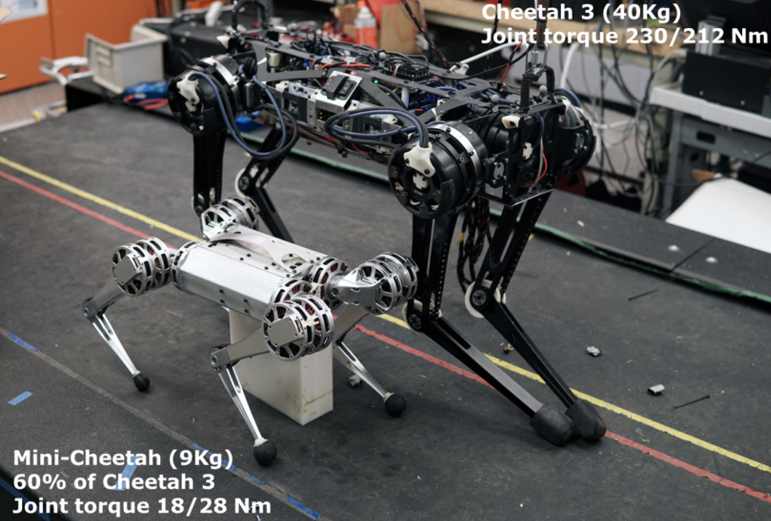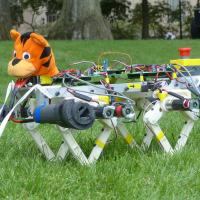| MIT's Cheetah Robots Exhibit Agility |
| Written by Lucy Black | |||
| Sunday, 03 March 2019 | |||
|
If you like acrobatic feats, the new video of MIT's Mini Cheetah is worth watching. It is the first quadruped robot to perform a backflip.
The Mini Cheetah is smaller, stripped down version of the Cheetah III being developed at the MIT Department of Mechanical Engineering's Biomimetic Robotics Lab under the direction of Associate Professor Sangbae Kim. Weighing only 20 pounds it can bend and swing its legs wide, enabling it to walk either right side up or upside down. It can also trot over uneven terrain about twice as fast as an average person's walking speed and has been trained to do backflips.. Back in 2015 Cheetah II made headlines, including ours for its dynamic legged gait, speed, jumping ability, and biomimetic design. Now Professor Kim's team is working on a third generation of the quadruped robots designed for ground mobility. In an interview about the Cheetah III, Kim explained: “With the Cheetah project, I was initially motivated by copying land animals, but I also realized there was a gap in ground mobility. We have conquered air and water transportation, but we haven’t conquered ground mobility because our technologies still rely on artificially paved roads or rails. None of our transportation technologies can reliably travel over natural ground or even man-made environments with stairs and curbs. Dynamic legged robots can help us conquer mobility on the ground.” A particular issue being addressed in the Cheetah project is that of the requirement for high torque actuators. As Kim noted: “A human hip joint can generate more torque than a sports car, but achieving such condensed high torque actuation in robots is a big challenge. Robots tend to achieve high torque at the expense of speed and flexibility." The high torque actuators used for factory robots are rigid and cannot absorb energy upon the impact that results from climbing steps. Hydraulically powered, dynamic legged robots, such as Boston Dynamic's larger, higher-payload, quadruped Big Dog, can achieve very high force and power, but at the expense of efficiency which, according to Kim is a serious issue with hydraulics, especially when you move fast,. For this reason a chief goal of the Cheetah project has been to create actuators that can generate high torque in designs that imitate animal muscles while also achieving efficiency. To accomplish this, Kim opted for electric rather than hydraulic actuators, saying: “Our high torque electric motors have exceeded the efficiency of animals with biological muscles, and are much more efficient, cheaper, and faster than hydraulic robots." In the Cheetah III, rather than improving speed and jumping capabilities the goal is a commercially viable robot with enhancements such as a greater payload capability, wider range of motion, and a dexterous gripping function. The Cheetah III will initially act as an inspection robot in hazardous environments such as a compromised nuclear plant or chemical factory. It will then evolve to serve other emergency response needs. While the Mini Cheetah resembles its big brother in many respects, it has lacks commercial pretensions and is intended for robotics research and education. There is, however, another projects, the MIT Super Mini Cheetah - an inexpensive and lightweight quadrupedal robot that is capable of behaviors such as running, walking, jumping and turning, the design of which emphasizes the use of commercial-off-the-shelf components and low-cost rapid manufacturing methods. Maybe this will have a future as an open source quadruped robot that can be forked. Meanwhile if you want to experiment in this area see OpenDog - Build Your Own Spot. Spot is of course the robot dog created by Boston Dynamics, the robotics company which started out as a spin-off from MIT, was acquired by Google and now owned by SoftBank. Spot's smaller version is SpotMini, which debuted in 2016 see Introducing SpotMini- A Domestic Pet Helper, is intended to be a commercial product and when we last reported on it, was with the headline SpotMini On Sale Soon. Even if Mini Cheetah isn't a robot that we will be able to buy it does seem to have a worthwhile role in research, with the aim of allowing robots to go where only animals have been able to go before.
More InformationCheetah III robot preps for a role as a first responder Related ArticlesMIT's Robot Cheetah Jumps Over Things In Realtime Robot Stunt Double Lands Perfectly Every Time Introducing SpotMini - A Domestic Pet Helper Atlas Goes For A Jog And Spot Mini On Sale Soon
To be informed about new articles on I Programmer, sign up for our weekly newsletter, subscribe to the RSS feed and follow us on Twitter, Facebook or Linkedin.
Comments
or email your comment to: comments@i-programmer.info |
|||
| Last Updated ( Sunday, 03 March 2019 ) |




